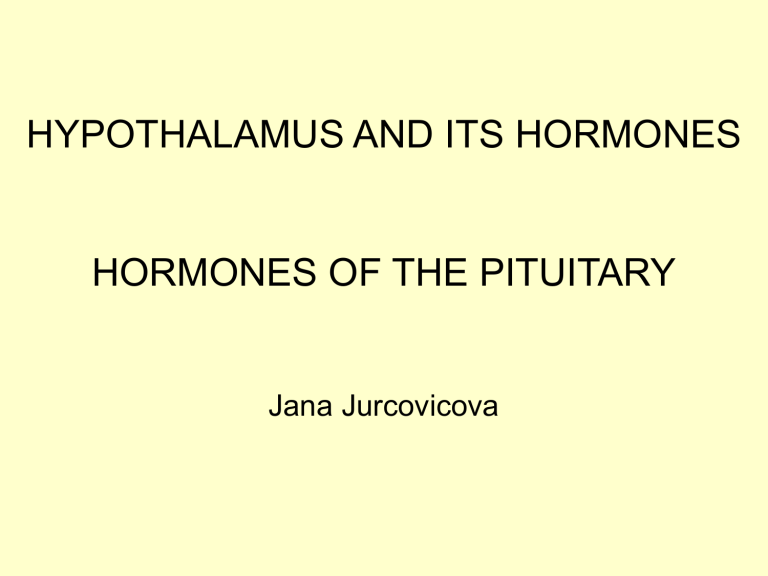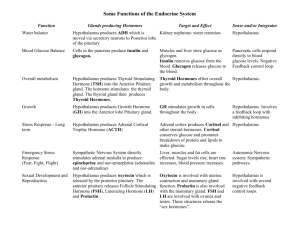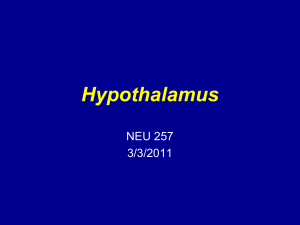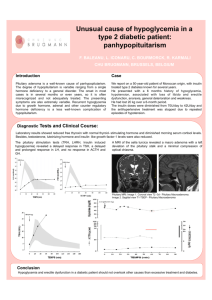growth hormone releasing hormone

HYPOTHALAMUS AND ITS HORMONES
HORMONES OF THE PITUITARY
Jana Jurcovicova
ANATOMICAL NOTES
Pituitary has a coordinating role in regulation of peripheral endocrine glands.
It is connected with with part of diencephalon - hypothalamus to form hypothalamo-pituitary complex.
Hypothalamus acts as a regulating and connecting center which enables the control of endocrine functions by central nervous system.
Hypothalamus is located on the base of third ventricle and extends between
- mammilary bodies (caudally)
- optic chiasm (frontally)
- optic tract (laterally)
- thalamus (dorsally)
On its base is median eminence, an important structure where converge regulatory pathways form hypothalamus into peripheral blood.
BASAL VIEW OF THE HYPOTHALAMUS
HYPOTHALAMO-HYPOPHYSEAL CONNECTION
Central part of neuroendocrine regulation is hypothalamo-hypophyseal complex.
Structural components of this complex are neurosecretory cells grouped into secretory nuclei located around the third ventricle. These secrete neuropeptides into portal blood connecting hypothalamus with adenopituitary. The other cell groups secrete neuropeptides to systemic circulation through posterior lobe via long axons of magnocellular hypothalamic neurons.
Pituitary is located in sella turcica and is composed from 2 distinct structures adenopituitary and posterior pituitary arcuate nucleus and other nuclei adenopituitar hormones supraoptic and paraventricular nuclei posterior pituitary hormones
ENDOCRINE HYPOTHALAMUS
Hypothalamic secretory nuclei synthesize neuropeptides regulating adenopituitary secretion. These either exert either stimulatory or inhibitory effects.
There are 4 stimulatory releasing hormones and 2 inhibitory statins releasing hormones: reproduction function activates gonadotropin releasing hormone - GnRH growth hormone activates growth hormone releasing hormone - GHRH thyroid function activates thyrotropin releasing hormone – TRH , adrenocortical function activates corticotropin releasing hormone – CRH.
inhibiting hormones (statins) growth hormone inhibits somatostatin - SRIF (mild inhibitory activity also on TSH) prolactin inhibits prolactostatin - dopamine
TOPOGRAPHY OF ENDOCRINE HYPOTHALAMUS
The highest endocrine activity resides in medial hypothalamus (tuberal region), then lateral and proptic regions
Medial hypothalamus: arcuate nucleus (ARC) containis GHRH, somatostatin and PIH, paraventricular nucleus (PVN) contains CRH and TRH.
Periventricular nucleus contains somatostatin.
Lateral hypotalamus: supraoptic nucleus (SON) contains neurohypophyseal hormons arginin-vasopressin (AVP or ADH) and oxytocin, suprachiasmatic jnucleus (SCN) which is a central pacemaker of daily rhythms
Preoptic region is rich in GnRH.
SCHEMATIC DRAWING OF HYPOTHALAMIC
NUCLEI
AC : anterior commissure PO : preoptic nucleus SC : suprachiasmatic nucleus OC : optic chiasma TC : tuber cinereum AP : anterior pituitary
IN : infundibulum: posterior pituitary ME : median eminence AH : anterior hypothalamic nucleus SO : supraoptic nucleus TH: thalamus
PV: paraventricular nucleus (not to be confused with periventricular nucleus, which is not shown) DM : dorsomedial nucleus VM: ventromedial nucleus AR : arcuate nucleus (associated with periventricular nucleus, which is not shown) LT: lateral nucleus PN: posterior nucleus MB : mamillary body
SCHEMATIC CROSS SECTION OF
HYPOTHALAMUS
Guyton and Hall, 2006
Ganong and Hall, 2006 suprachiasmatic
CROSS-SECTION OF THE ROSTRO - MEDIAL
PART OF THE BRAIN
CROSS- SECTION OF THE MIDDLE PART OF
THE BRAIN
HISTOCHEMICAL STAINING OF
HYPOTHALAMIC NUCLEI
HYPOTHALAMIC HORMONES
SECRETED HORMONE abbr PRODUCED BY
Thyrotrophic-releasing hormone
(Prolactin-releasing hormone)
Dopamine
(Prolactin-inhibiting hormone)
Growth hormone-releasing hormone
Somatostatin
(growth hormone-inhibiting hormone)
Gonadotropin-releasing hormone
TRH,
PRH
DA or
PIH
GHR
H
SS,
GHI
H, or
SRIF
GnR
H or
LHR
H
Parvocellular neurosecretory neurons
Dopamine neurons of the arcuate nucleus
Neuroendocrine neurons of the
Arcuate nucleus
Neuroendocrine cells of the
Periventricular nucleus
Neuroendocrine cells of the Preoptic area
Corticotropin-releasing hormone
Oxytocin
Vasopressin
(antidiuretic hormone)
CRH
ADH or
AVP
Parvocellular neurosecretory neurons
Magnocellular neurosecretory cells
Magnocellular neurosecretory neurons
EFFECT
Stimulate thyroid-stimulating hormone (TSH) release from anterior pituitary (primarily)
Stimulate prolactin release from anterior pituitary
Inhibit prolactin release from anterior pituitary
Stimulate Growth hormone (GH) release from anterior pituitary
Inhibit Growth hormone (GH) release from anterior pituitary
Inhibit thyroid-stimulating hormone (TSH) release from anterior pituitary
Stimulate follicle-stimulating hormone (FSH ) release from anterior pituitary
Stimulate luteinizing hormone (LH) release from anterior pituitary
Stimulate adrenocorticotropic hormone (ACTH) release from anterior pituitary
Uterine contraction
Lactation (letdown reflex)
Increase in the permeability to water of the cells of distal tubule and collecting duct in the kidney and thus allows water reabsorption and excretion of concentrated urine
HYPOTHALAMO – PITUITARY CONNECTION
Neurons of medial and preoptic hypothalamus end in the external layer of median eminence. Here they secrete neurohormones into primary plexus of portal vein system which converges along the pituitary stalk into the long veins. The neurohormones are then transported to adenopituitary secretory cells by veins of secondary blood plexus.
The existence of releasing / inhibiting hormone dates back to early
70-ties of the last century, when in was first proved that adenipotuitary is regulated by humoral factors coming from the hypothalamus.
Many neurohormones are produced also in GIT and are released into circulation. Therefore the concentration of releasing hormones in portal blood must be higher than in peripheral blood system.
HYPOTHALAMO – PITUITARY CONNECTION
HYPOTHALAMO-PITUITARY REGULATION
DEVELOPMENT AND STRUCTURE OF PITUITARY diencephalon
Rathke’s pouch of pharynx ectoderm neural tissue anterior posterior pars tuberalis pars distalis pars nervosa pars intermedia
HYPOTHALAMO - PITUITARY SYSTEM
Nc. paraventricularis
Hypothalamic neurons secreting releasing, inhibiting hormones (nuclei:nARC, mPOA NPE)
Nc. supraopticus
Primary capilary plexus
Portal vein
Chiasma opticum
Secretory cells
ACTH, GH,
TSH, LH, FSH, Prolactin
Neural lobe
Adenopituitary
Anterior lobe
Oxytocin
Vasopresin
INNERVATION OF ANTERIOR AND
POSTERIOR PITUITARY BY NEURONES OF
PARAVENTRICULAR AND SUPRAOPTIC
NUCLEI
STRUCTURES OF ARGININE VASOPRESSIN
AND OXYTOCIN
LIST OF PITUITARY HORMONES
STRUCTURE OF PROOPIOMELANOCORTIN
PC1 – PROHORMONE CONVERTASE1
PC2 – PROHORMONE CONVERTASE2
REGULALION OF ENDOCRINE HYPOTHALAMUS
Feedback regulations
Neural inputs - mainly from higher CNS centers
Inputs from peripheral blood - leptin, ghrelin, insulin, cytokines , adenopituitary hormones, plasma levels of glucose, osmolality, steroid hormones (gonadal steroids and corticosteroids)
Light photoperiod for the synchronization of circadian rhythms
Stress – various stress stimuli depending on the character of stressor
FEEDBACK REGULATIONS
REGULATION OF HYPOTHALAMIC
HORMONES BY SHORT LOOP AND
ULTRASHORT LOOP FEEDBACK
REGULATION OF HYPOTHALAMIC
HORMONES BY COMPLEX FEEDBACK
SDDDDDDDDDDD
NEURAL STIMULI OF THE HYPOTHALAMUS
NEURON synaptic buttons dendrites nucleus myelin
Ranvier cleft oligodendroglia mitochondrion exocytosis axon vesicles with mediator synapse postsynaptci receptots
NEUROTRANSMITTER SYSTEMS REGULATING
HYPOTHALAMIC SECRETION
SEROTONIN
DOPAMINE nigrostriatal pathway mesocortical pathway v tuberoinfundibular pathway
NORADRENALINE
NEUROTRANSMITTES REGULATING INDIVIDUAL
RELEASING HORMONES
Although many findings come from animal studies and cannot be applied to human physiology absolutely, the principal regulatory mechanisms are equal.
It is generally accepted that central noradrenaline plays a pivotal role in stimulation of GHRH, CRH, AVP a TRH .
The effect of noradrenaline on GnRH is unequivocal.
Central serotonin stimulates the secretion of GHRH and also pituitary prolactin via its not yet known releasing hormone.
Central dopamine participates in the inhibition of GnRH and in stimulation of CRH.
CRH is also stimulated by acetylcholine.
BLOOD BORNE STIMULI OF THE HYPOTHALAMUS
BLOOD BRAIN BARRIER (BBB)
Neurotransmitters and other molecules affecting neurosecretory activity of the hypothalamus (toxins, inflammatory agents) are found also in the circulation.
Hypothalamus is protected from these influences by blood brain barrier (BBB).
BBB is a complex mechanism regulating exchange of mediators between blood and
CNS. It functions as protection from harmful stimuli (toxins) and also as transport system (for example glucose) into brain.
BBB represented by tight junctions between endothelial capillary cells which are 100 times tighter than junctions in peripheral veins. These junctions are formed by ineractions of transmembrane proteins (claudins, occludins), adhesion molecules and cytoplasmic proteins (zona ocludens) bound to cytoskeletal actin filaments.
BBB undergoes dynamic change during maturation, aging, under the influence of toxins or stress.
For neuroendocrine secretion it is important that not all areas in brain are protected by
BBB. These are: pineal gland, posterior pituitary, median eminence, and region around the third ventricle: area postrema, subcommissural organ, subfornical organ and organom vasculosum laminae terminalis
BRAIN ENDOTHELIAL CELL – CELL
TIGHT JUNCTIONS linked to actin skeleton transmembrane molecules adhesion molecules
Engelhardt and Sorokin, 2009
AREAS WITHOUT BLOOD BRAIN BARRIER
OVLT - organum vasculosum laminae terminalis; SFO – subfornical organ; ME – median eminence;
SCO – subcomissural organ; PG – pineal gland; PL – posterior lobe; AP - area postrema;
MODULATION OF ADENOPITUITARY
RESPONSIVENESS TO HYPOTHALAMIC
REGULATION
HYPOTHALAMIC REGULATION OF FOOD INTAKE
PHYSIOLOGY OF GROWTH HORMONE - GH
INCREASES PROTEIN SYNTHESES
DECREASES UTILIZATION OF CARBOHYDRATES IN MUSCLE
STIMULATES OSTEOBLAST GROWTH AND IGF-I
HIGH LEVELS ARE DIABETOGENIC
STIMULATES IMMUNE SYSTEM
REGULATION OF GROWTH HORMONE (GH )
SECRETION
GROWTH HORMONE CHANGES DURING THE DAY
Guytom and Hall, 2006
NORMAL FUNCTIONS OF GH PRODUCED BY THE
BODY
Main pathways in regulation of growth and etabolism
Effects of growth hormone on the tissues is anabolic.
Increased height during childhood is the most widely known effect of GH. Height is stimulated by at least two mechanisms:
1.Through receptor mechanism GH directly stimulates division and multiplication of chondrocytes and osteoblasts.
2.GH also stimulates the production of insulin-like growth factor 1 (IGF-1, formerly known as somatomedin C), a hormone homologous to proinsulin The liver is a major target organ of GH for this process and is the principal site of IGF-1 production. IGF-1 has growth-stimulating effects on a wide variety of tissues. IGF-1 is generated within target tissues, thus it is an endocrine and paracrine hormone.
IGF-1 also has stimulatory effects on osteoblast and chondrocyte activity to promote bone growth.
GH Increases calcium retention, and strengthens the mineralization of bone
GH increases muscle mass through sarcomere hyperplasia
GH promotes lipolysis, release of FFA from fat tissue and enhanced production of acetyl-CoA
GH inncreases protein synthesis by increased transport of aminoacids into cells
GH decreases glucose uptake in skeletal muscle and fat – hyperglycemic effect
GH increases glucose production by the liver
GH (in excess) promotes insulin resistance
GH stimulates the immune system
INSULIN-LIKE GROWTH F-1 (IGF-1) AND GROWTH
IGF-1
[U/ml]
10
6
4
2
1 gigantism / acromegaly treatment - somatostatin normal GH-deficit
(treatment
– GH administration)
PHYSIOLOGY OF PROLACTIN - PRL
STIMULATES LACTATION (MILK PROTEIN CASEIN)
STIMULATES IMMUNE SYSTEM (DIRECT EFFECT ON IMMUNE CELL
PROLIFERATION)
ANTIGONADAL ACTION (PROGESTERONE)
HORMONE LEVELS DURING PREGNANCY AND
LACTATION
A- HCG
B-ESTROGENS
C-PRL
D-PROGESTERONE
EFFECT OF BREST FEEDING ON PRL RELEASE
PRL levels in women after brest feeding on days
2, 4 ,6, post partum
A- good lactation
B- medium lactation
C- poor lactation
F - before feeding
G - after feeding
THE PINEAL GLAND
Known over 2000 years
Producing hormone of the night – MELATONIN
It aggregates pigment granules containing melanin, and thus makes the skin lighter.
Pineal gland EPIPHYSIS has a shape of a pine cone
HISTOLOGY OF PINEAL GLAND
The pineal is consists of connective tissue , blood vessels , glial cells , and pinealocytes (which secrete melatonin).
Pinealocytes have larger, lighter staining nuclei glial cells have small darker staining nuclei.
With age, calcified formations appear in the pineal gland ( brain sand or corpora aranacea ).
CIRCADIAN REGULATION OF MELATONIN
PRODUCTION
LIGH
Synthesis of
N-acetyl transferases
ß-adrenergic receptors
α -adrenergic receptors
HINDBRAIN
SPINAL CORD
Superior cervicale ganglion
24-HOUR SECRETION OF MELATONIN IN
HEALTHY AND ARTHRITIC RATS
250
200
150
100
50
0
14 18
**
MELATONIN
**
**
22 hour
2
**
6
+
10
+
MAEN AC
MEAN cFA
CIRCADIAN SYNCHRONIZATION
CIRCADIAN OSCILATOR - SCN
Principle of the circadian rhythmicity of the SCN are feedback mechanisms of clock genes
SYNCHRONIZATION of the internal environment is the light/dark cycle
Synhesis and release of melatonin is regulated from SCN, but synchronized by light/dark cycle.
RHYTHM of melatonin secretion is indicator of CIRCADIAN
PACEMAKER
EFFECTS OF MELATONIN: improves quality of sleep activates immune system antioxidant (prevents oxidative stress)







